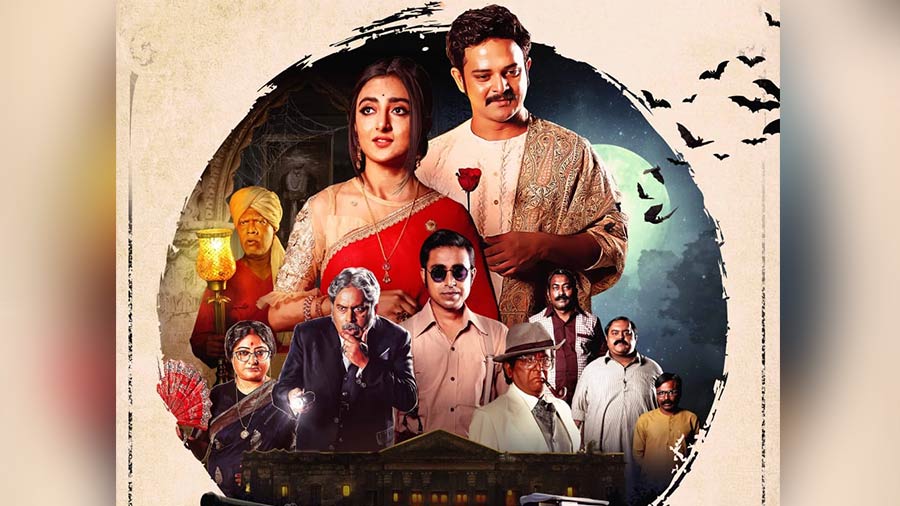In its rather frenetic last act, there’s a sequence — played almost as a throwaway, and hence that much more delectable — that kind of defined the pleasures of Anirban Bhattacharya’s feature debut, Ballabhpurer Roopkotha, for me.
The resident ghost of the 400-year-old palace (built in 1561, a year bandied about with frantic regularity by all and sundry) has just made an appearance in royal finery. He recites Kalidas in his sonorous voice, captivating the young heart of Chhanda (Surangana Bandopadhyay, a throwback to the Bengali heroine of the 1960s), the daughter of the eccentric businessman B.P. Haldar (played with a strong Utpal Dutt hangover by Sandip Bhattacharya). Much to the chagrin of her mother, Swapna Haldar (Jhulan Bhattacharya), who mistakes the spirit for the only surviving descendant of the Ray dynasty, Bhupati Ray (Satyam Bhattacharya).
She rebukes him for trying to seduce her daughter, and as the hapless ghost flees her verbal onslaught, she follows, and ends up daring him to try some of that ‘Sanskrit shloka’ on her. I know it does not come off well in the writing here but the onscreen execution is bang on. Very droll. And that’s a word that applies to most of what’s on display in Ballbhpurer Roopkotha.
In Badal Sircar’s writing lies the film’s primary triumph
After the heroics of Mandaar, Anirban trades the grim and dark moral landscape of Shakespeare’s Macbeth for the dark (literally so here, with most of the action taking place in a dimly lit crumbling mansion at night) and yet comic fairy-tale world of Badal Sircar in one of his most genial works, one that is devoid of the overt social-political-historical context generally associated with the playwright. And in this master’s writing lies the primary triumph of the film. So much so that the opening credits of the film feature a wonderful tribute to Badal Sircar through a song.
Bhupati Ray has inherited little more than a dilapidated estate runover by snakes and bats, and a crushing debt. Owing money to almost everyone around him, he has no pretensions about his lineage, though his loyal manservant Monohor (Shyamal Chakraborty) still has some illusions left, upbraiding his master for sleeping in a gamchha (he is the first of the illustrious family who does so, Monohor rebukes him) and refusing to share a beedi with him (too proletariat for the ‘royal’ scion even if he is on the brink of financial collapse).
Bhupati would like nothing more than to purchase a chamber and get started on his medical practice in the city. That, however, is easier said than done thanks to the wandering spirit of an ancestor who met a rather gruesome death. Now, Raghu-da is an affable ghost who enjoys what is a genial relationship with the mansion’s two living inmates. But there’s no doubt that he gives the estate a rather dubious reputation. Enter soap baron Haldar, determined to best his old rival in the stakes for landing himself a piece of ‘history’. Determined to palm off the property, master and servant hatch an elaborate scheme, one that is fraught with peril given how punctual Raghu-da is (appearing without fail every night at eleven).
Orchestrating the stage-to-screen adaptation
Though the film’s theatrical roots are apparent – most of the action unfolds in one location – the director orchestrates it brilliantly. Just consider the pre-title sequence, where Anirban and his co-writer Prateek Dutta deviate from the original play to set up the premise in a stunningly visual manner. He is helped in no mean manner by the team at his disposal.
Soumik Haldar’s cinematography is a class act, making the most of the limitations of space through imaginative framing (Anirban sure has a thing for the top-shot), including one gorgeously shot outdoor sequence involving an out-of-focus car with a grasshopper on the tip of a leaf in focus in the foreground. The visual aesthetic is reinforced by an innovative set design which gives the film its atmosphere and succeeds in breaking the monotony that one indoor location could otherwise entail. The background score is an important part of the narrative here and underlines the fairy-tale nature of the narrative. The performances are uniformly good with Shyamal Chakraborty, the beating heart of the film, a standout.
An important film in Bengali cinema
The writing contributes immensely to the film’s overall effect, and Anirban weaves in his own bits (that delightful play of words about ‘Monohori’, involving Monohor and his ‘twin’ Horihor) that merge seamlessly with Badal Sircar’s. The repartee flows thick and fast, and though the wordplay maybe be lost on a non-Bengali viewer (there is no way a subtitle can convey the essence of ‘apnaar bhoote apotti na thakle amaar nitey aapotti keno thakbe’), it is to the credit of the filmmaker that he pulls off the difficult task of merging the disparate elements of comedy, romance and horror.
This is an important film as far as Bengali cinema is concerned, which is going through what is without a doubt its most barren phase in years, both creatively and commercially. It seems to have become intellectually bankrupt, with established filmmakers seeming to have run out of ideas, regurgitating old tropes ad nauseum – a fact that the title song cheekily alludes to with its reference to detective and adventure films.
Anirban Bhattacharya, fast emerging as a beacon of hope for a moribund industry, shows it is possible to entertain the audience without flogging a dead horse, and within the limitations of modest budgets and with a non-star cast. All it takes is imaginative writing and execution, and a willingness to break the tyranny of playing safe. If the almost houseful late-night show at a Kolkata suburb is any indication, the audience is ready. It is up to the filmmakers now to walk the talk.
Shantanu Ray Chaudhuri is a film and music buff, editor, publisher, film critic and writer.










